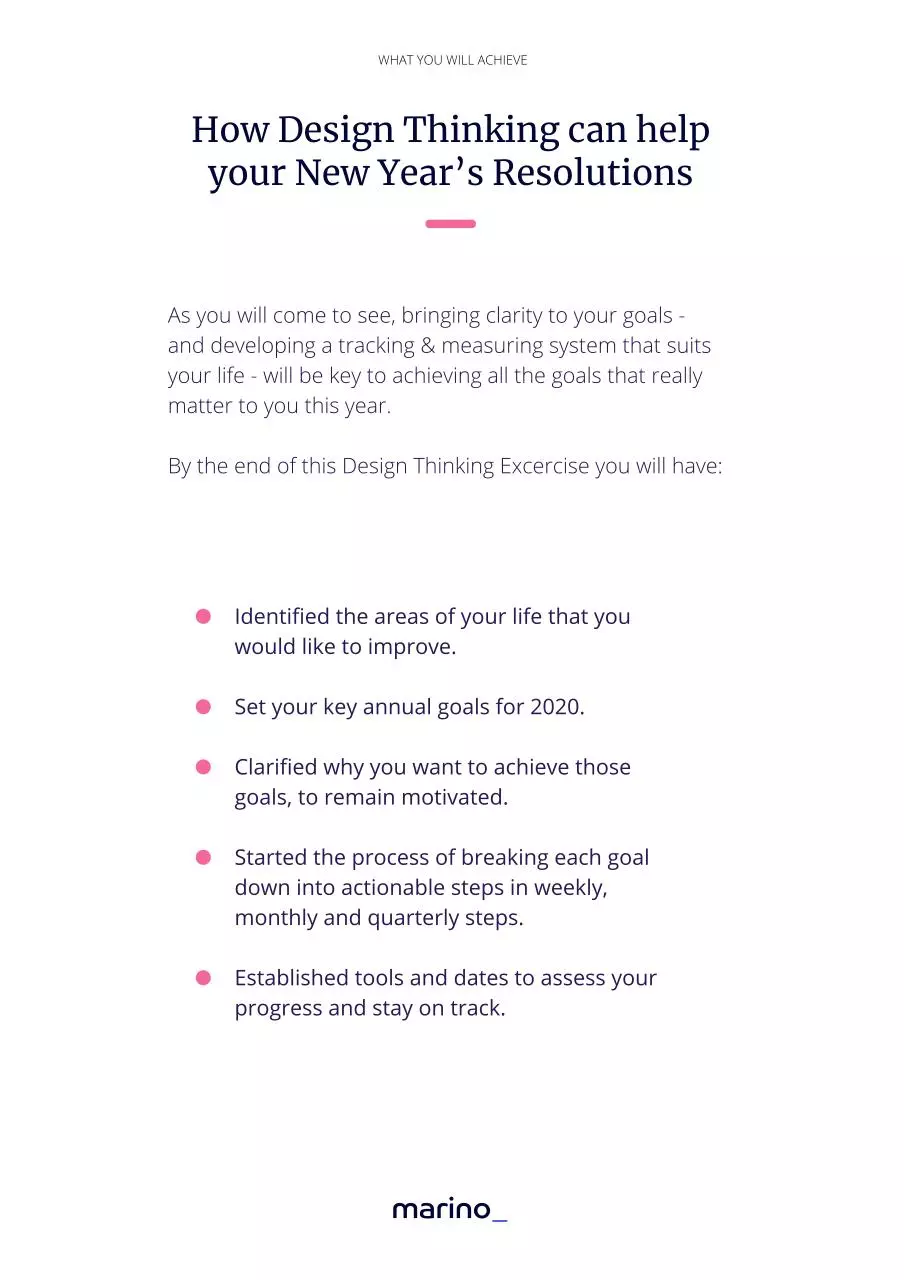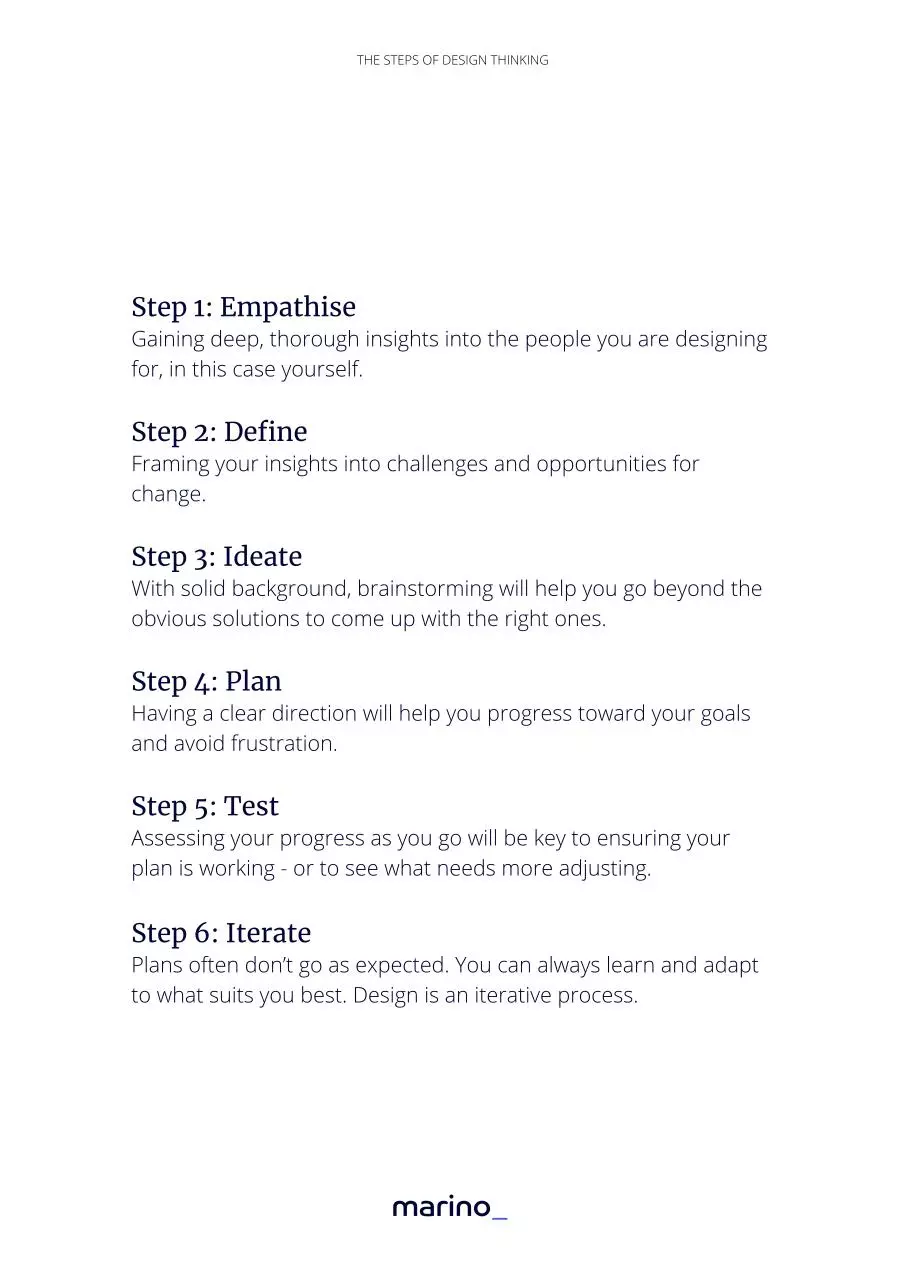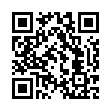Marino Software Bullet Journal (PDF)
File information
This PDF 1.7 document has been generated by PDFium, and has been sent on pdf-archive.com on 24/01/2020 at 13:39, from IP address 136.206.x.x.
The current document download page has been viewed 315 times.
File size: 4.72 MB (37 pages).
Privacy: public file





File preview
marino
WHAT YOU WILL ACHIEVE
How Design Thinking can help
your New Year’s Resolutions
As you will come to see, bringing clarity to your goals and developing a tracking & measuring system that suits
your life - will be key to achieving all the goals that really
matter to you this year.
By the end of this Design Thinking Excercise you will have:
Identified the areas of your life that you
would like to improve.
Set your key annual goals for 2020.
Clarified why you want to achieve those
goals, to remain motivated.
Started the process of breaking each goal
down into actionable steps in weekly,
monthly and quarterly steps.
Established tools and dates to assess your
progress and stay on track.
THE STEPS OF DESIGN THINKING
Design Thinking, as 6 steps
to better Goal Planning
According to IDEO,
“Design thinking is an iterative process which seeks to understand
users, challenge assumptions, redefine problems and create
innovative solutions to prototype and test. The method is most
useful when you want to tackle problems that are ill-defined or
unknown”.
For the purpose of this exercise, we have adapted its phases to:
Empathise
1
Iterate
D e fi n e
2
3
6
5
Test
4
Plan
Ideate
THE STEPS OF DESIGN THINKING
Step 1: Empathise
Gaining deep, thorough insights into the people you are designing
for, in this case yourself.
Step 2: Define
Framing your insights into challenges and opportunities for
change.
Step 3: Ideate
With solid background, brainstorming will help you go beyond the
obvious solutions to come up with the right ones.
Step 4: Plan
Having a clear direction will help you progress toward your goals
and avoid frustration.
Step 5: Test
Assessing your progress as you go will be key to ensuring your
plan is working - or to see what needs more adjusting.
Step 6: Iterate
Plans often don’t go as expected. You can always learn and adapt
to what suits you best. Design is an iterative process.
Ready?
STEP 1: EMPATHISE
Step 1: Empathise
"Engaging with people directly reveals a
tremendous amount about the way they think and
the values they hold. Sometimes these thoughts
and values are not obvious to the people who hold
them. A deep engagement can surprise both the
designer and the designee by the unanticipated
insights that are different from what they actually
do - are strong indicators of their deeply held
beliefs about the way the world is."
Interaction Design Foundation
Empathising is gaining a deep, thorough understanding of
the people you are designing for, in this case yourself.
What are your needs, thoughts, emotions and motivations?
Use the Wheel of Life to reflect and get a sense of your life
as a whole. How satisfied do you feel in each aspect of life?
Which areas would you like to work on? Ask yourself and
mark on the wheel:
Where am I now in this area, from 1-10?
STEP 1: EMPATHISE / THE WHEEL OF LIFE
Wheel of Life
Using your first gut instinct, rate the ten areas of
life from 1-10 (1 being very dissatisfied and 10
super satisfied).
CAREER
IT Y
SK
IL L
S
E N V IR O
NME
NSHIPS
ATIO
REL
N TS
M
CO
N
MU
IF E
E
AD V
AL L
N TU R
ES
S P IR IT U
HE
AL
TH
&F
IT N
F
ESS
LO V E
* SEE EACH AREA’S DESCRIPTION ON THE NEXT PAGE.
IN A
N
CE
STEP 1: EMPATHISE / GAINING MORE INSIGHTS
FINANCE:
.
CAREER:
SKILLS:
LOVE:
ENVIRONMENTS:
RELATIONSHIPS:
SPIRITUAL LIFE:
HEALTH & FITNESS:
ADVENTURES:
COMMUNITY:
Your bank account, as well as your relationship and beliefs about money.
What you do for a living.
Career skills but also skills in your hobbies / areas of interest.
Your love relationship, but also your readiness, ideas and beliefs about love relationships.
The places you inhabit daily: your home, car, office, the cafe you frequent or hotels you stay in.
Your friendships and family life.
Your sense of connection to yourself, others, life in general and its meaning to you.
How healthy and fit you feel.
How
important is a sense of adventure to you: trying new things, visiting new places, etc.
How do you contribute to the broader community around you and what is your impact on it.
Before we move on to defining your goals, gain deeper
insight by reflecting on the following questions:
Observe which areas seem most attractive/urgent for you
to focus on:
Why is it important to me and others to improve in this
area?
Thinking of what motivates you to change will be a good
reminder going forward.
Finally, consider what would a 10 score in this area feel
like:
How do I envision myself in this area, in one year?
Clearly visualize yourself already having made all the
changes you wish for: what do you see, hear, smell, touch,
feel? Make your vision as vivid and full of detail as possible.
STEP 2: DEFINE
Step 2: Define
What challenges do you want to solve in each area?
Use the chart on the following page to write down your
challenges in statements such as:
“I want to...”
Example:
- I want to help tackle climate change
- I want to feel closer to my family and friends
- I want to be able to play with my grandkids when I’m 80
What could help you solve these challenges?
As we do in Design Thinking, you can ask yourself “How
Might I?” (HMI) questions. These have to be broad
enough to inspire lots of solutions. Write the questions
only, for now. We will get to the answers later.
“How might I … ?“
Example:
- How might I learn some basics?
- How might I lose the fear?
- How might I find the time?
STEP 2: DEFINE / CHALLENGES
AREA
CHALLENGE
I...
STEP 2: DEFINE / HOW MIGHT I
HOW MIGHT I...
STEP 3: IDEATE
Step 3: Ideate
Take the HMI questions and start coming up with lots of
ideas on how you could solve them. It is useful to use
sticky notes on a big board for this.
Try to push your ideas beyond the obvious, go as broad
and wild as you can at this stage.
Take
some
lessons
Sleep 6hs
instead
of 8
Eat
Healthy
Everyday
a
Take al
tic
sabba
Change
Career
Become
100%
plastic free
Move
Country
Become
an Athlete
Sell my
Car
STEP 3: IDEATE / PRIORITISE & DECIDE
Prioritising solutions &
Defining Goals
Which solutions would help you achieve your goals?
One good way of narrowing down your choices is to
think about which ones could have the most impact
with the least effort. Work smart, not hard - right?
Place the solutions you came up with in the Impact /
Effort Matrix (next page) to see which ones are worth
developing further.
Decide on your Goals and Motivations
The solutions on the “Go Ahead” window will be the
best candidates for your 2020 New Year Resolutions.
You can use the Goals & Motivations chart on the
following pages to write down your chosen annual
goals.
If you feel you have picked more goals than you can
tackle, you can use the Impact/Effort matrix again until
you have narrowed it down to 5-10 worthy goals.
At this point, it is important to ask yourself again what
are your main motivations for achieving each goal. You
can revisit this document anytime you feel like you
have lost motivation or direction.
STEP 3: IDEATE / THE IMPACT / EFFORT MATRIX
The Impact / Effort Matrix
IMPACT
Use this matrix to prioritise the solutions that will be
most helpful, and the goals that will bring you the most
joy / have the biggest impact.
STEP 3: IDEATE / PRIORITISE & DECIDE
EFFORT
STEP 3: IDEATE / PRIORITISE & DECIDE
GOALS
STEP 3: IDEATE / PRIORITISE & DECIDE
MOTIVATIONS
STEP 4: PLAN
Step 4: Plan
Time to get your action plan ready!
Break down your goals into small, measurable and
actionable steps*. These steps might take the shape of a
once-off action/event or they might be a new habit you
need to build.
GOA
BecomL:
100% p e
las
free tic
Example:
Today: Research how to get started.
This week: Purchase/make items I will need, like glass jars.
This month: Find plastic free stores & suppliers.
This quarter: Reduce my recycling bins to no more than one
full bin per month.
This year: Go at least 6 months without any plastic waste.
Now that you have decided on the steps you can transcribe
this action plan into your Bullet Journal.
*About SMART goals:
Specific
You can describe
your goal clearly
and consisely.
Measurable Attainable
You can easily
know when you
have reached
your goal.
Relevant
You can reach the Your goal is in
goal with existing alignment with
or easy to gather your other goals.
resources
Timely
You can set a time
limit or deadline
for your goal.
STEP 4: PLAN
How to use your Bullet
Journal
Your Bullet Journal is a living organisational tool that allows
you to make changes easily and create your own spreads.
These will keep your Year, Months and Weeks focused.
YEARLY
2020
January
February
July
August
March
April
September
October
May
June
November
December
MONTHLY
1
2
3
4
5
6
7
8
9
10
11
12
...
W
T
F
S
S
M
T
W
T
F
S
S
Monthly tasks
WEEKLY
Monthly goals
1
2
3
4
You can also store
collections in your journal
such as the books you want
to read, places you’d like to
visit or your watchlist. We
included some handy
templates for this in your
Journal.
Monday
Thursday
Tuesday
Friday
Wednesday
Saturday Sunday
STEP 5: TEST
Step 5: Test
Similarly as we do with prototyping, once you come up
with a solution or idea, you want to test it and validate
these steps are going to help you reach your goals.
Tracking and measuring are one of the most important
tools for developing successful products & services, and
the same applies to your goals: assessing your progress
regularly will keep you motivated and on track.
Pick some dates throughout the year to check your
progress.
A good frequency would be a monthly, quarterly and
annual assessment. Some people also include quick
weekly checks to stay on track: they do 50 push ups each
Saturday morning. If on any given Saturday they are not
able to go through the 50, it means something needs
adjustment - be it exercise routines, sleep or food.
About Developing Habits:
A good technique to help these new habits stick is to
associate them to a trigger, like ‘after I get home in the
evening’ or ‘after I brush my teeth’, to make sure you don’t
forget. You can also make them part of your morning or
bedtime routine.
STEP 5: TEST
Regular Progress Tracking
At the end of every week or month, take some time to ask
yourself a few quick questions to see if your steps are
working. These are some good questions to assess
yourself:
Example:
What brought me the most joy?
What new thing have I learnt?
What new ideas did I have?
What have I been most focused on?
What were my top 3 wins?
What areas can I improve on and how?
Looking at my main goals one by one, how am I progressing
so far? Is there anything I need to adjust?
“Deciding on what
activities are worth
your time is the
difference between
being busy or being
productive.”
STEP 6: ITERATE
Step 6: Iterate
Sometimes an assessment might indicate that you are not
progressing the way you had set out to - that’s no problem!
Design thinking is iterative by nature and looks for solutions
when things don’t go as expected. Take this as an
opportunity to tweak your resolutions and smart steps if
they are not working out, instead of giving up altogether.
You can go back to the Ideate stage any time and come up
with an improved plan that suits you better.
We created these handy templates to
help you reach your goals & develop
new habits.
Here is where you can track all of the
goals you came up with during your
New Year’s Design Thinking exercise.
Happy Goal Setting, from all of us at
Marino Software!
2020 Goals
Quarterly Goals
Checking your progress regularly keeps you
focused on your end goal. Break down your yearly
goals into quarterly goals
Jan-Mar
Jul-Sep
Apr-Jun
Oct-Dec
Breaking down your goals
Once you have broken down your goals into
actionable steps, write down what you need to
achieve, month by month.
January
February
March
April
May
June
July
August
September
October
November
December
Habit Tracker
It takes practice & consistency to form a new
habit. Use this chart to track your progress on
new habits through the month. We’ve included
two to get you started!
MONTH:
1
2
3
Habit: Sleep more
4
5
6
Habit:
7
Habit:
8
9
Habit:
10
Habit:
11
12
13
14
31
15
30
16
29
17
18
28
19
20
21
22
23
24
25
26
27
3
4
MONTH:
1
2
Habit:
5
Habit:
7
6
8
Habit:
9
Habit:
14
13
12
11
10
Habit:
15
31
16
30
17
29
28
27
18
26
25
24
23
22
21
20
19
Mood Tracker
Your moods through the year, at a glance:
give each mood a look or colour to note your
mood each day
JAN
FEB
MAR
APR
MAY
JUN
JUL
AUG
SEP
1
2
3
4
5
6
7
8
9
10
11
12
13
14
15
16
17
18
19
20
21
22
23
24
25
26
27
28
29
30
31
Pick a pattern or
colour for each
mood:
Energetic
Tired
Focused
Angry
Anxious
OCT
NOV
DEC
Saving Buckets
What would you like to save for this year? Colour
up the jars as you progress towards your targets
€
€
€
€
€
€
€
€
€
€
€
€
€
€
€
€
€
€
€
€
€
€
€
€
€
€
€
€
€
€
€
€
€
€
€
€
Things I want to learn
Name each shape and colour them in as you
learn to keep track of your progress
Places I want to go
Colour or mark in the places you
visit this year
1
5
2
6
3
7
4
8
Books I want to read
Keep track of the books you read this year: you
can colour in each one once you’ve read it
Watch list
Keep track of recommendations right here!
MOVIE
1
2
3
4
5
6
7
8
9
10
11
12
13
14
15
16
RATING
SEEN
We listen.
We partner.
We craft.
We solve.
marino
Download Marino Software-Bullet Journal
Marino Software-Bullet Journal.pdf (PDF, 4.72 MB)
Download PDF
Share this file on social networks
Link to this page
Permanent link
Use the permanent link to the download page to share your document on Facebook, Twitter, LinkedIn, or directly with a contact by e-Mail, Messenger, Whatsapp, Line..
Short link
Use the short link to share your document on Twitter or by text message (SMS)
HTML Code
Copy the following HTML code to share your document on a Website or Blog
QR Code to this page

This file has been shared publicly by a user of PDF Archive.
Document ID: 0001935996.